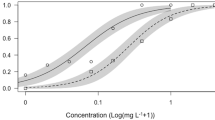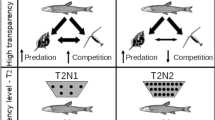Summary
Field distribution patterns and laboratory feeding experiments have suggested that blooms of colonial blue-green algae strongly inhibit relatively large-bodied daphnid cladocerans. We conducted laboratory experiments to test the hypothesis that blooms of the colonial blue-green alga Microcystis aeruginosa would shift competitive dominance away from large-bodied daphnid cladocerans toward smaller-bodied cladocerans, copepods, and rotifers. In laboratory competition experiments, increasing the proportion of M. aeruginosa in the algal food supply resulted in a shift from dominance by the relatively largebodied cladoceran Daphnia ambigua to dominace by the copepod Diaptomus reighardi. The small-bodied cladoceran Bosmina longirostris was always numerically heavily dominant over D. ambigua, but its estimated population biomasses were only slightly higher than those of D. ambigua. Daphnia ambigua consistently outcompeted the rotifer Brachionus calyciflorus. Our results demonstrate that blooms of M. aeruginosa can alter zooplankton competitive relations in laboratory experiments, favoring small-bodied cladocerans and copepods at the expense of large-bodied cladocerans. However, contrary to predictions, blooms of M. aeruginosa did not improve the competitive ability of rotifers.
Similar content being viewed by others
References
Allan JD (1977) An analysis of seasonal dynamics of a mixed population of Daphnia, and the associated cladoceran community. Freshwater Biol 7:505–512
Brooks JL, Dodson SI (1965) Predation, body size, and composition of plankton. Science 150:28–36
Burns CW, Gilbert JJ (1986a) Effects of daphnid size and density on interference between Daphnia and Keratella cochlearis. Limnol Oceanogr 31:848–858
Burns CW, Gilbert JJ (1986b) Direct observations of the mechanisms of interference between Daphnia and Keratella cochlearis. Limnol Oceanogr 31:859–866
Carpenter SR, Kitchell JF, Hodgson J (1985) Cascading trophic interactions and lake productivity. Bioscience 35:643–639
DeMott WR, Kerfoot WC (1982) Competition among cladocerans: Nature of the interaction between Bosmina and Daphnia. Ecology 63:1949–1966
Dodson SI (1974) Zooplankton competition and predation: An experimental test of the size-effeciency hypothesis. Ecology 55:605–613
Edmondson WT, Litt AH (1982) Daphnia in Lake Washington. Limnol Oceanogr 27:272–293
Fulton RS III, Paerl HW (1987a) Effects of colonial morphology on zooplankton utilization of algal resources during blue-green algal (Microcystis aeruginosa) blooms. Limnol Oceanogr 32:634–644
Fulton RS III, Paerl HW (1987b) Toxic and inhibitory effects of the blue-green alga Microcystis aeruginosa on herbivorous zooplankton. J Plankton Res 9:837–855
Gilbert JJ (1985) Competition between rotifers and Daphnia. Ecology 66:1943–1950
Gilbert JJ, Stemberger RS (1985) Control of Keratella populations by interference competition from Daphnia. Limnol Oceanogr 30:180–188
Gliwicz ZM (1977) Food size selection and seasonal succession of filter feeding zooplankton in an eutrophic lake. Ekol Pol 25:179–225
Goulden CE, Henry LL, Tessier AJ (1982) Body size, energy reserves, and competitive ability in three species of Cladocera. Ecology 63:1780–1789
Gurevitch J, Chester ST Jr (1986) Analysis of repeated measures experiments. Ecology 67:251–255
Infante A, Richl W (1984) The effect of Cyanophyta upon zooplankton in a eutrophic tropical lake. Hydrobiologia 113:293–298
Lampert W (1982) Further studies on the inhibitory effect of the toxic blue-green Microcystis aeruginosa on the filtering rate of zooplankton. Arch Hydrobiol 95:207–220
Lynch M (1978) Complex interactions between natural coexploiters-Daphnia and Ceriodaphnia. Ecology 59:552–564
Lynch M, Weider LJ, Lampert W (1986) Measurement of the carbon balance in Daphnia. Limnol Oceanogr 31:17–33
Murphy JS (1970) A general method for the monoxenic cultivation of the Daphnidae. Biol Bull 139:321–332
Neill WE (1975) Experimental studies of microcrustancea competition, community organization, and efficiency of resource utilization. Ecology 56:809–826
Neill WE (1984) Regulation of rotifer densities by crustaccan zooplankton in an oligotrophic montane lake in British Columbia. Oecologia (Berlin) 61:175–181
Orcutt JD Jr, Pace ML (1984) Seasonal dynamics of rotifer and crustacean zooplankton populations in a eutrophic monomictic lake with a note on rotifer sampling techniques. Hydrobiologia 119:73–80
Paerl HW (1983) Factors regulating nuisance blue-green algal bloom potentials in the lower Neuse River, N.C. Univ North Carolina Water Resources Res Inst Report Number 188, p 41
Paerl HW (1987) Dynamics of blue-green algal (Microcystis aeruginosa) blooms in the lower Neuse River, NC: Causative factors and potential controls. Univ North Carolina Water Resources Res Inst Report Number 229, p 176
Peters RH, Downing JA (1984) Empirical analysis of zooplankton filtering and feeding rates. Limnol Oceanogr 29:763–784
Porter KG (1984) Natural bacteria as food resources for zooplankton. In: Klug MJ, Reddy CA (eds) Current perspectives in microbial ecology. Am Soc Microbiol, Washington, DC, pp 340–345
Porter KG, McDonough R (1984) The energetic cost of response to blue-green algal filaments by cladocerans. Limnol Oceanogr 29:365–369
Richman S, Dodson SI (1983) The effect of food quality on feeding and respiration by Daphnia and Diaptomus. Limnol Oceanogr 28:948–956
Romanovsky YE, Feniova IY (1985) Competition among Cladocera: effect of different levels of food supply. Oikos 44:243–252
Smith DW, Cooper SD (1982) Competition among Cladocera. Ecology 63:1004–1015
Starkweather PL, Kellar PE (1983) Utilization of cyanobacteria by Brachionus calyciflorus: Anabaena flos-aquae (NRC-44-1) as a sole or complementary food source. Hydrobiologia 104:373–377
Stemberger RS, Gilbert JJ (1985) Body size, food concentration, and population growth in planktonic rotifers. Ecology 66:1151–1159
Tessier AJ, Goulden CE (1987) Cladoceran juvenile growth. Limnol Oceanogr 32:680–686
Threlkeld ST (1986) Resource-mediated demographic variation during the midsummer succession of a cladoceran community. Freshwater Biol 16:673–683
Tillmann U, Lampert W (1984) Competitive ability of differently sized Daphnia species: an experimental test. J Freshw Ecol 2:311–323
Vanni MJ (1986) Competition in zooplankton communities: suppression of small species by Daphnia pulex. Limnol Oceanogr 31:1039–1056
Webster KE, Peters RH (1978) Some size-dependent inhibitions of larger cladoceran filterers in filamentous suspensions. Limnol Oceanogr 23:1238–1245
Williamson CE, Butler NM (1986) Predation on rotifers by the suspension-feeding calanoid copepod Diaptomus pallidus. Limnol Oceanogr 31:393–402
Author information
Authors and Affiliations
Rights and permissions
About this article
Cite this article
Fulton, R.S., Paerl, H.W. Effects of the blue-green alga Microcystis aeruginosa on zooplankton competitive relations. Oecologia 76, 383–389 (1988). https://doi.org/10.1007/BF00377033
Received:
Issue Date:
DOI: https://doi.org/10.1007/BF00377033




